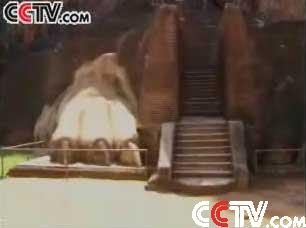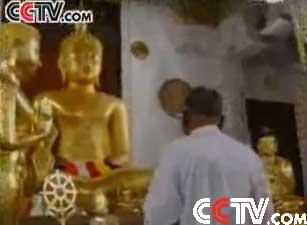Source: CCTV.com
03-05-2007 12:38
Sri Lanka has a proud civilization stretching back more than two thousand years. The remains of the country's ancient and medieval civilizations bear witness to thriving kingdoms and the influence of Buddhism. Five areas have been designated as World Heritage sites by UNESCO, and four of these are located in the same region, dubbed the Cultural Triangle.
 |
The Cultural Triangle contains Sri Lanka's and Asia's richest archaeological heritage sites. The area formed by linking the ancient capitals of Anuradhapura, Polonnaruva, and Kandy, with Sigiriya in the center.
Nothing in Sri Lanka captures the imagination more than a 200-meter lump of granite that rises starkly above the flat central plains.
1500 years ago in Anuradhapura, the reign of King Dhatusena came to an abrupt end when his throne was seized by his son Kasyapa.
Kasyapa in turn fled the capital to escape his brother. He built his palace on Sigiriya Rock, a perfect lookout which could be easily defended. A huge lion was carved out of the rock, giving rise to Sigiriya's an alternative name, Lion Rock.
Only the lion's massive paws remain today, a clue to the size of the gigantic carving.
This is one of the most famous stories in Sri Lanka. Today, after over 1000 years, the 1200-step climb to the top of the rock is rewarded with a beautiful view! The King built the palace using his considerable power, but in the process, lost his kingdom.
Inside a grotto on Sigiriya's sheer west face, beautiful maidens still smile. Nobody knows who painted these amazing frescoes, but the Maidens testify to a highly advanced Sinhalese civilization at a time when Europe was in the Dark Ages.
After leaving Sigiriya, we went south for the famous Buddhist city of Kandy, on the south tip of the Cultural Triangle.
It's home to the Temple of the Tooth Relic, the most sacred place of worship in the Buddhist world.
Sri Lanka is one of the oldest Buddhist countries. About 70 percent of the population believe in Buddhism, and the religion plays an important part in their daily lives. In the city of Kandy, Buddhism's influence is especially strong.
The 16th Century temple houses a tooth believed to be that of Lord Buddha. Throughout history, the relic was regarded as a royal treasure and symbol of kingship, protected by the king himself. Today, Buddhist pilgrims come from the world over to the temple.
Mudiyanse Konara, a pilgrim, said, Buddhism is very important in my life. Buddhism touches every part of my life. So I have a happy, perfectly satisfactory life. I hope my whole family will continue this kind of happy life."
Every year, Kandy sees the 10-day ritual of the Esela Perahera in July or August.
 |
Crowds watch a majestic tusker proudly lead over more than a hundred elephants, ridden by the custodians and other officials dressed in the traditional Sinhalese attire of chieftains.
The sound of conch shells and whips starts off the excitement.
Then traditional drums, Kandyan dancers, acrobats, and other artists transport the audience back in time.
Editor:Liu Fang
